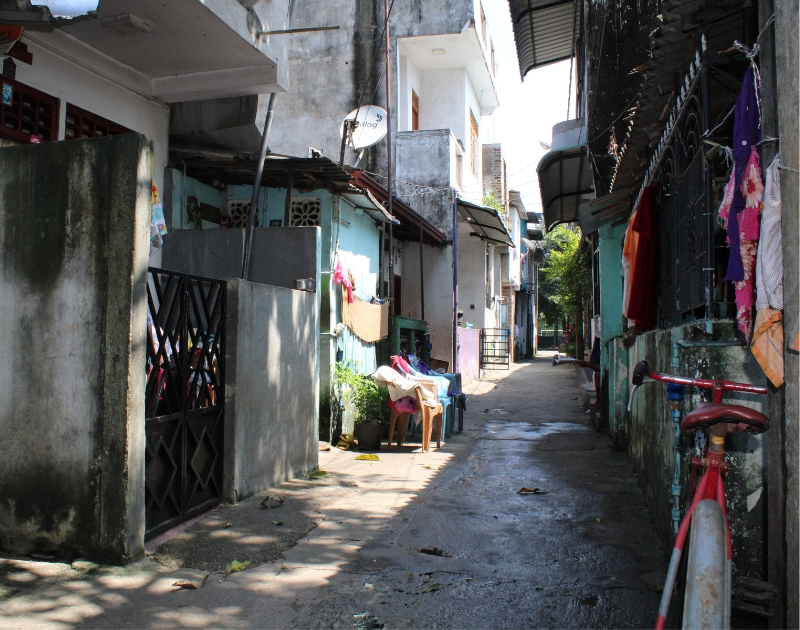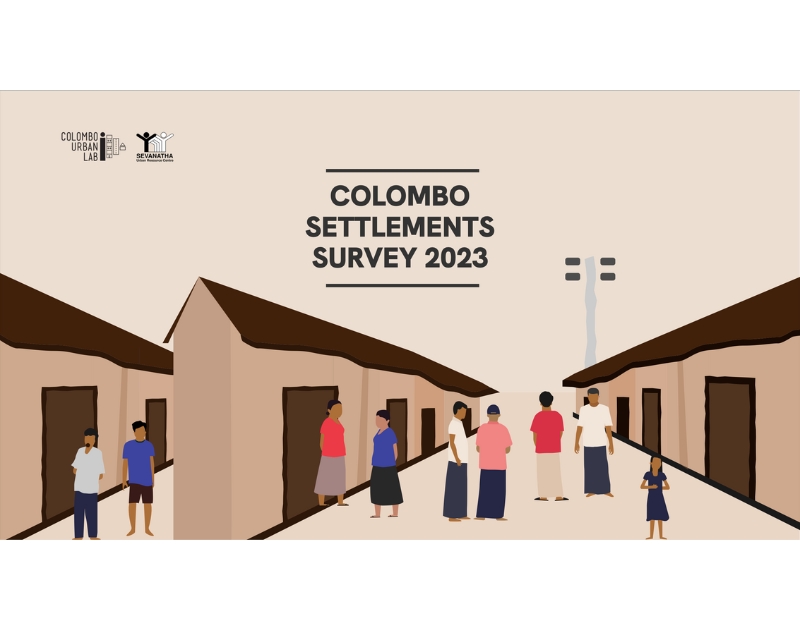
- Home
- Knowledge Insights
- Behind the scenes: Colombo Settlements Survey 2023
The Colombo Settlements Survey 2023 (CSS) is a survey of the physical and socio-economic conditions of settlements in Colombo, conducted once every ten years. Prior to the 2023 survey, the survey was conducted in 2001 and 2012. In 2023, the survey was conducted by SEVANATHA Urban Resource Centre in collaboration with Colombo Urban Lab (CUL).
While the data collected via the survey provides useful information to public officials and policy makers, a comprehensive understanding of the realities of these settlements can only be obtained by also looking at the way in which the data has been collected. In other words, the numbers generated through the survey are only enriched through an understanding of the methodology of the survey.
As one of the enumerators recalled at a briefing held after the completion of the data collection, “The survey was a good way to see the City of Colombo” – especially as these settlements in the City of Colombo are not provided as much visibility as the skyscrapers that cloud its skyline. The survey is an important reminder that the way people live their lives is far from homogeneous, and that we need to acknowledge and be sensitive to the different conditions in which people live.
The data collected in 2012 revealed that there were 1735 settlements in the City of Colombo, and that approximately 50% of the population in Colombo lived in these settlements. Those who have not had the chance to visit a settlement, may presume, solely based on the numbers, that approximately 50% of the population lives in poor-quality housing, where access to basic services is minimal. However, while the data collected via the 2023 survey reveals that the number of settlements in the City of Colombo has reduced to 1360, the data also reveals that most of the houses in the settlements are on-site upgraded housing as people have improved their housing (i.e., by adding a second floor for instance) over the years. This illustrates perfectly why it is important to pay attention to the methodology, and look at the data through the lens of someone on the ground. This blog post briefly explores the method of empirical data collection in the survey and provides a starting point for students, researchers and policy makers interested in conducting large-scale surveys and data collection.
Preparing for the Survey
A survey of over one thousand settlements takes months of communication and coordination across various stakeholders—all with different interests. The 2023 survey started with a literature review, after which the indicators used to assess the settlements in 2012, were reviewed and updated, keeping in mind the changes that have taken place in the past ten years. The 2023 survey saw an addition of 7 new indicators, which sought to capture the socio-economic conditions of people living in the settlements. These indicators were decided through multiple rounds of consultations with stakeholders who had years of experience conducting similar surveys on the field and those who worked on subject matters specific to the survey indicators, such as housing or infrastructure. This was followed by a listing and coding of all the settlements in Colombo.
Although the number of active Community Based Organisations (CBO) in the settlements are low, community leaders from when they were active are still a strong voice in many of the settlements. SEVANATHA conducted awareness meetings for the CBO leaders to brief them about the scope of the survey. Most of the community leaders already knew of SEVANATHA as they had worked together for previous surveys, and so the process was relatively easier. SEVANATHA also organised field visits to familiarise the researchers, field officers and enumerators to the field sites. Observations from these visits were later discussed at a briefing after the visit.
The ten field enumerators recruited for the 2023 survey were all graduates with degrees in town and country planning, sociology, social work and political science from the University of Moratuwa and the University of Sri Jayewardenepura in Sri Lanka. Although these enumerators did not have as much experience conducting surveys previously, the two-day training provided by SEVANATHA on the various aspects of conducting the survey including how the questions were to be asked, division of labour within each group of enumerators etc. prepared the graduates for three months of data collection. In addition to the training received on conducting the focus group discussions, enumerators also received training on mapping and developed skills on identifying existing boundaries of settlements, which they would map by walking around the settlement and marking the existing boundaries on their mobile phones or physical maps. Prior to the FGD, maps were developed for each settlement. The pilot FGD was thereafter led by the senior officials at SEVANATHA, with the participation of all enumerators.
Conducting the Survey
The trained enumerators made their way to the field between 9.30am -11.00am on at least four days in the five-day work week. After a morning briefing at the SEVANATHA premises, the ten enumerators were transported to the field sites in a van, where they would conduct FGDs in groups of two. Having spoken to the community members or a community leader prior to their arrival (i.e., on a previous day), and confirmed a time that would be convenient for the FGD, the enumerators would ask their contact to gather anyone that is willing to participate in the discussion and begin with a briefing of the scope of the data collection. Prior to the FGD, the enumerators would have shared a document that sought to collect basic information about the settlement, including the number of houses, families, population etc. in each settlement.
In most cases, a majority of the FGD participants were women, as the men would typically be away from home for work during that time of the day. As the enumerators are divided into groups of two, one would conduct the interview and ask the questions from the community members, while the other would take down the information in a survey form used to collect information per settlement. In the absence of a community leader or someone who could bring together the required number of FGD participants, enumerators found it difficult to gather a reasonable number of individuals for the FGD. In addition to this, cultural factors would also deter some community members from participating in the survey. For instance, women were sometimes hesitant to speak to male enumerators in the absence of a male family member. Enumerators also found it challenging to engage the community, in the absence of some type of compensation or reward for their time spent on the FGD.
The questionnaire/survey form had two main types of questions— (1) those that asked for precise information about the settlement and (2) open ended questions. The enumerators noted that while it was a little difficult to get information on the former (i.e., even after forms to collect basic information on the settlement were handed over prior to the date of the FGD), the community was more receptive to the open-ended questions, specifically on what issues they face within the settlement. Navigating these conversations were also particularly tricky-for instance, while enumerators had to allow the community to express their grievances, they were also mindful of keeping such conversations short, so that it would not disturb the rest of the scheduled FGDs for the day. As most settlements had a small number of houses, enumerators would be able to, at times, physically count the number of houses within the settlement. This highlights that while the FGDs were an important source of information on the settlement, enumerators refrained from taking this information for granted, often verifying information provided by the community members independently.
The number of settlements they could conduct surveys in increased as they became more familiarised with the questionnaire. The day would typically end at around 3.30pm, after which enumerators would head back home. The survey forms were submitted to SEVANATHA the following day, which would then be reviewed. Any gaps in information or completing the form would be addressed on one of the days of the week.
In Conclusion
While data and numbers offer helpful insights, the picture it paints is almost always incomplete without an understanding of how those numbers were arrived at—how data is collected, and the sensitivities that enumerators need to be mindful of when conducting large scale surveys. Understanding the methodology of conducting such surveys add an important realistic dimension to policies that are solely data-driven.
Read the full Colombo Settlements Survey 2023.


